Glossary:Anti-aliasing (AA)
Graphics and video
Resolutions
Video settings
- Field of view (FOV)
- Windowed / borderless fullscreen
- Anisotropic filtering (AF)
- Anti-aliasing (AA)
- High-fidelity upscaling
- Vertical sync (Vsync)
- Frame rate (FPS)
- High dynamic range (HDR)
- Ray tracing (RT)
- Color blind mode
Hardware
For a list of games, see List of games that support anti-aliasing (AA).
Anti-aliasing (AA) is a computer graphics technique that attempts to minimise the unwanted 'staircase' or jagged object outlines which occur due to the limited resolution in 3D-Renderers, essentially by 'smoothing' these lines.[1]
Example of anti-aliasing
| No Anti-aliasing | 16x Anti-aliasing |
|---|---|
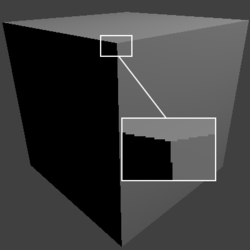 |
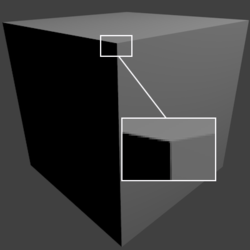
|
Types of anti-aliasing
There are a number of anti-aliasing techniques today but all of them are based on the same principle. They simply render multiple pixels per pixel of the final image.
The techniques only differ on two factors:
- How they determine which pixels are aliased.
- How they "mix" the multiple rendered pixels to get the final pixel.
Those algorithms are also variable on how many pixels they use to determine one final pixel. In video games this is represented by a simple number which is a power of 2 like 2x, 4x, 8x etc.
There are several terms associated with anti-aliasing, most of which are derivatives on the standard anti-aliasing formula.
Traditional methods
- The result is much sharper and cleaner than post-processing methods.
- Forcing isn't guaranteed to work in games utilizing deferred shading[2]. This can be worked around by downsampling (with results similar to SSAA).
- Usually quite taxing on resources. Post-processing methods can be used as alternative for lesser performance hit.
- Doesn't counter the most extreme cases of temporal aliasing.[3]
Super-Sampling Anti-Aliasing (SSAA)
- Also known as Full Scene Anti-Aliasing (FSAA) and often interchangeable with the term downscaling.
- Technically when implemented correctly, these do differ in that downscaling applies to an entire frame buffer – 2D and 3D Elements, while SSAA/MSAA are techniques only applied internally to 3D elements. In some implementations this can result in a lesser performance impact and better compatibility.
- Applies the general anti-aliasing formula to full screen images, reducing the "staircase effect". When compared to a rendered image undergoing MSAA, an SSAA/FSAA image will appear smoother (more or less dependent on the specific type of rescaling filter used)[4].
- Implemented on Nvidia systems as OGSSAA (Ordered Grid Supersample Anti-Aliasing) and enabled with the following modes using Nvidia Profile Inspector; 2x1, 1x2, 2x2, 3x3, 4x4.
- Has largely been replaced by less resource intense methods due to the huge frametime costs, but due to the better result that it provides, some games still adopt it as an option in the in-game settings.[5]
Multi-Sample Anti-Aliasing (MSAA)
- Essentially a "budget" version of Super-Sampling.
- To reduce the stress that SSAA/FSAA puts on a system, multi-sampling optimizes the process by evaluating each pixel only once, with true super-sampling only occurring at the edges of a rendered object, and to depth values. This results in a similar (but less drastic) improvement in visual quality whilst reducing the load put on the system to render and downscale such high resolutions.[6]
- Primarily clears up aliasing on geometry; temporal aliasing and aliasing from shader effects, textures and transparencies will not be affected.[7]
Multi-Frame Anti-Aliasing (MFAA)
- Nvidia GeForce GTX 900 series and higher (Basically successor to CSAA).[8]
- Meant to be used in conjunction with MSAA for lowered performance hit.
- According to Nvidia it reduces performance cost while used with high resolutions and is more flexible to needs of different game engines due to its programmability.[9]
- One note of importance is that MFAA doesn't function properly below 40FPS. Below that threshold, MFAA causes smearing and blurring in motion.[10]
- Possibly also disables D3D11 Driver Command Lists, killing multi-threaded rendering (and thus performance when CPU-limited).[11]
Coverage Sampling Anti-Aliasing (CSAA)
- QCSAA variant is supposed to increase the quality even further.
- Nvidia GeForce 8000 Series and higher.[12]
- Maxwell based GPUs such as GTX 750 Ti, GTX 800M/900 series and newer removed the support.[13]
- Aims to further reduce the additional stress that MSAA puts on the system, with Nvidia claiming that a CSAA-rendered image will rival 8x-16x MSAA whilst only putting a load on the system comparable to 4x MSAA. It does this by reducing the number of settings each sample determines (by creating a new sample for coverage) whilst increasing the overall number of samples.
Quincunx Super Anti-Aliasing (QSAA)
- Nvidia exclusive.
- Improves on standard MSAA somewhat. For example, 2x QSAA roughly equates to 3x MSAA in terms of quality.[14]
Enhanced Quality Anti-Aliasing (EQAA)
- AMD Radeon HD 6900 series and higher.[15]
- AMD claims it offers enhanced AA quality over standard MSAA modes by adding more coverage samples per pixel but keeping the same number of color/depth/stencil samples to achieve better AA quality than standard MSAA modes.[15]
Sparse Grid Super-Sampling Anti-Aliasing (SGSSAA)
- Nvidia exclusive.
- Modern version of SSAA, possessing superior quality to other anti-aliasing methods at a steep performance cost.
- Comes in two forms: FSSGSSAA (Full Scene Sparse Grid Supersampling Anti-Aliasing, more commonly simply called SGSSAA) and TrSGSSAA (Transparency Sparse Grid Supersampling Anti-Aliasing, more commonly called TrSSAA).[16]
- Transparency version is enabled simply by setting it in Nvidia control panel. Full Scene requires one to set Antialiasing - Mode to Override any application settings, Antialiasing - Setting to either 2x 4x or 8x multisampling and Antialiasing - Transparency to the same value as Antialiasing - Setting.[17] Note that the game may need a particular compatibility string, see here for more info; Nvidia Profile Inspector is needed.
Hybrid-Sampling Anti-Aliasing (HSAA)
- Combination of SSAA and MSAA.
- Nvidia users can use Nvidia Profile Inspector to force a version that uses ordered-grid SSAA with regular MSAA in some games (modes with the xS extension); more information about Nvidia's implementation can be found on the second sheet of this document.
- Sometimes works in cases where SGSSAA doesn't work or is too blurry due to a driver bug.
Post-processing methods
- Less taxing on resources than traditional methods.
- Applied after the image is rendered, unlike traditional methods. This means they are virtually compatible with every game, video or even still picture possible.
- Due to this, the image (textures in particular) can sometimes become blurry, so much that overall quality could become worse than the original if implemented poorly. Blurring can be mitigated to an extent with image sharpening.[18][19]
- Must be applied before rendering the HUD elements of a game, lest it affect them too.
Fast Approximate Anti-Aliasing (FXAA)
- Does not require large amounts of computing power. It achieves this by smoothing jagged edges ("jaggies")[20] according to how they appear on screen as pixels, rather than analyzing the 3D models itself as in conventional anti-aliasing.
- However, the image quality improvement it provides is significantly less impressive than traditional AA methods such as MSAA.[21] The effect can also be applied twice by two separate tools (i.e. ingame setting and driver control panel or injector and driver control panel, etc.) or on top of SMAA or TAA to further remove jaggies, but will likely also make blurring worse as well as increase performance impact.[22][23]
- Nvidia's response to AMD's MLAA.
Morphological Anti-Aliasing (MLAA)
- Available on AMD cards on Windows and can be forced for all games through the display driver control panel regardless of graphics API being used, as well as OpenGL games on Linux with Mesa drivers.
- Has a larger performance impact than FXAA.[24][25]
Subpixel Morphological Anti-Aliasing (SMAA)
- Can be injected in most games through ReShade (even with depth-based edge detection)
- Based on MLAA. Image quality varies from game to game due to differing implementations, but it is arguably better than FXAA or MLAA.[26]
Subpixel Reconstruction Anti-Aliasing (SRAA)
- Currently only Unigine 2.13 uses this technique.[27]
- SRAA resembles Morphological Antialiasing (MLAA).[28]
Conservative Morphological Anti-Aliasing (CMAA)
- CMAA is positioned between FXAA and SMAA 1x in computation cost (1.0-1.2x the cost of default FXAA 3.8 and 0.55-0.75x the cost of SMAA 1x).
- Compared to FXAA, CMAA provides significantly better image quality and temporal stability as it correctly handles edge lines up to 64 pixels long and is based on an algorithm that only handles symmetrical discontinuities in order to avoid unwanted blurring.[29]
Directionally Localized Anti-Aliasing
Not to be confused with the Deep Learning Anti-Aliasing (DLAA) feature of Nvidia's Deep Learning Super-Sampling (DLSS) technology.
- Used primarily in Star Wars: The Force Unleashed II, but can be found in some other games, especially on Unity engine.
- According to the author, it's comparable with Morphological Anti-Aliasing (MLAA), but with better temporal stability.[30]
- GDC 2011 presentation and PowerPoint.
Temporal methods
- Work with much of the same general idea of Super-sampling, but to a much lower (almost negligible) performance cost since extra information is extracted from subsequent new frames.
- Most methods cause significant blurring and ghosting while in motion, especially at lower resolutions.
- Image quality itself can become dependent on framerate[31]
Temporal Anti-Aliasing (TAA)
- Catchall term for various temporal methods.
- Some games will offer two or more levels of TAA, sometimes one being named "Upscaled TAA", which is less detailled. (e.g, Jurassic World Evolution, No Man's Sky)
- Not confined to a particular manufacturer.
- Forced on in a few games.
Temporal Anti-Aliasing (TXAA)
- Nvidia GeForce GTX 600 series and higher.[32]
- Film–style technique designed specifically to reduce temporal aliasing (crawling and flickering seen in motion when playing games).[33]
- Combines some elements of MSAA with filters similar to those employed in CG films to produce a smooth image.[33]
Temporal Super-Sampling Anti-Aliasing (TSSAA)
- Also known as TMAA.
- Applies anti-aliasing not only to the current frame but also to some frames that were rendered before, restoring the old positions of pixels by using their velocity. This creates smoother and more cinematic images in the game, while only slightly increasing the load on the video card.[34]
Deep Learning Anti-Aliasing (DLAA)
Nvidia's Deep Learning Anti-Aliasing (DLAA) method works by using their Deep Learning Super Sampling (DLSS) algorithm but providing it with a frame rendered at native resolution, identical to that of the desired output target. This allows using the anti-aliasing feature of DLSS without relying on the upscaling feature, and as the input resolution is much higher than otherwise, the anti-aliasing feature has more details and data to work with.
The end result is a natively rendered and temporally anti-aliased image that is more stable in motion than many alternatives, with more fine-grained detail than DLSS as a result of the higher resolution of the input frame.
When placed as a separate option, "DLAA" locks the input resolution of DLSS to 1.0 (native res) and does not allow it to fall below that regardless of the FPS it results it. Games that uses DLSS's built-in dynamic resolution scaler can engage DLAA automatically if the dynamic resolution scaler determines that the system has room for it and if the game allows the input resolution of DLSS to go above the currently configured quality preset (e.g. Quality/0.67).[35]
- As DLAA is DLSS but with an input resolution of 1.0 (native res), all tools and configurations that apply for DLSS (such as the DLSS indicator) also apply for DLAA.
Reconstruction methods
Reconstruction anti-aliasing attempts to reduce processing-demands on the GPU by rendering at lower resolutions, then upscaling to the output-resolution, anti-aliasing in the process (typically by using a temporal anti-aliasing method).
Hybrid Reconstruction Anti-Aliasing (HRAA)
- Hybrid solution of hardware sampling, postprocessing, temporal and analysis.[36]
Other reconstruction methods
See the High-fidelity upscaling glossary page for breakdowns of more modern alternatives such as Nvidia's DLSS, AMD's FSR, and Intel's XeSS. Those techniques typically work by combining a high-quality upscaling algorithm with a temporal anti-aliasing pass.
Quality comparisions
| Call of Duty: Ghosts | Elite: Dangerous |
|---|---|
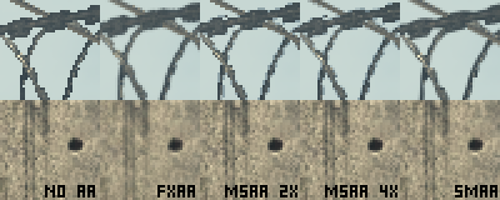 |
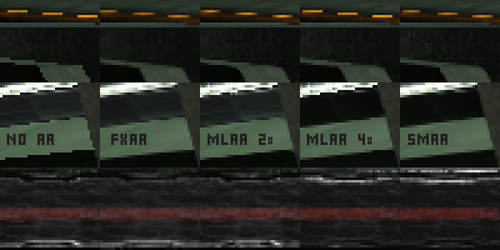
|
| Far Cry 4 | Shadow Warrior (2013) |
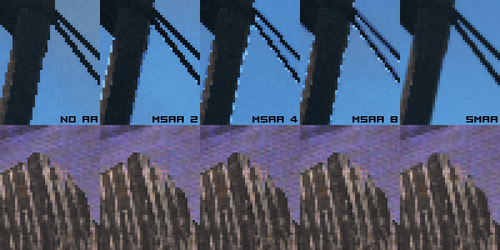 |
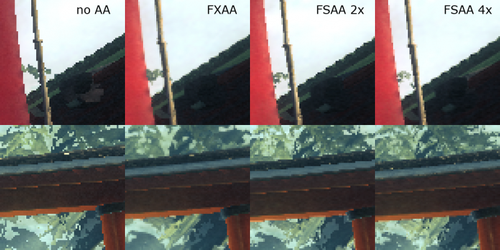
|
Forcing anti-aliasing
| Program | Available forms of AA |
|---|---|
| AMD Catalyst Control Center | MLAA, SSAA, MSAA, EQAA |
| dgVoodoo 2 | SSAA, MSAA |
| DRI (driconf, adriconf) | MLAA |
| injectSMAA | SMAA |
| Intel Graphics Control Panel | CMAA |
| Intel Graphics Command Center | MSAA, CMAA |
| Nvidia Control Panel | FXAA, MSAA, DSR (SSAA-like), CSAA, MFAA |
| Nvidia Profile Inspector | FXAA, SSAA, MSAA, CSAA, QSAA, SGSSAA, MFAA |
| Nvidia X Server Settings | FXAA, SSAA, MSAA |
| RadeonPro | FXAA, SMAA |
| ReShade | FXAA, SMAA, CMAA, DLAA, TAA |
| vkBasalt | FXAA, SMAA |
References
- ↑ Anti-aliasing article on Wikipedia
- ↑ Deferred shading - Wikipedia, the free encyclopedia - last accessed on 2016-6-14
- "One more rather important disadvantage is that, due to separating the lighting stage from the geometric stage, hardware anti-aliasing does not produce correct results anymore since interpolated subsamples would result in nonsensical position, normal, and tangent attributes."
- ↑ Tech Focus: TAA - Blessing Or Curse? Temporal Anti-Aliasing Deep Dive - YouTube
- ↑ Serious Statistics: The Aliasing Adventure - Results pt. 1 (Serious Sam Fusion 2017) - Overclockers Club
- ↑ Supersampling
- ↑ Multisample anti-aliasing
- ↑ Diving into Aliasing - Beyond3D - last accessed on 2016-6-19
- ↑ MFAA supported GPUs on GeForce.com - last accessed on 2016-4-29
- ↑ Technology of MFAA on GeForce.com - last accessed on 2016-4-29
- ↑ NVidia Anti-Aliasing Guide (updated) thread - Guru3D - last accessed on 2021-4-9
- ↑ 3DMark Draw Calls, Single Threaded Faster - Guru3D.com Forums
- ↑ CSAA (Coverage Sampling Antialiasing) article - Nvidia.com - last accessed on 2024-01-05
- ↑ Very few Anti Aliasing options - confirmed by NV represetative at Geforce Forums - last accessed on 2016-4-29
- ↑ MSAA and QSAA thread - Overclockers - last accessed on 2016-4-29
- ↑ 15.0 15.1 EQAA Modes for AMD 6900 Series Graphics Cards (PDF document) - last accessed on 2016-4-29
- ↑ SGSSAA - Natural Opinions - last accessed on 2016-6-14
- ↑ https://www.reddit.com/r/Battletechgame/comments/971m33/perfect_graphics_how_to_set_up_nvidia_sgssaa_in/
- ↑ Helpful Tip: Anti-Aliasing Improved (NVIDIA)
- ↑ TAA, FXAA, MSAA. TAA and Nvidia sharpening? What settings to use for the sharpening filter?
- ↑ FXAA: Anti-Aliasing at Warp Speed - GeForce.com - last accessed on 2016-4-29
- ↑ Fast Approximate Anti-Aliasing (FXAA) - Coding Horror - last accessed on 2016-4-29
- ↑ FXAA control panel vs ingame
- ↑ How to configure FXAA/smaa preset commands?
- ↑ HardOCP - NVIDIA's New FXAA Antialiasing Technology - last accessed on 2018-07-25
- ↑ Tom's Hardware - AMD Radeon HD 7870 And 7850 Review: Pitcairn Gets Benchmarked - last accessed on 2018-07-25
- ↑ SMAA: Enhanced Subpixel Morphological Antialiasing - last accessed on 2016-6-14
- ↑ UNIGINE 2.13 - GPU Lightmapper, Volumetric Clouds Upgrade, Better AA, New Terrain Tools - last accessed on 2023-10-10
- ↑ Nvidia Research - Subpixel Reconstruction Antialiasing - last accessed on 2023-10-10
- ↑ Conservative Morphological Anti-Aliasing (CMAA) - Intel.com - last accessed on 2016-4-29
- ↑ Real-time Frame Rate Up-conversion for Video Games (SIGGRAPH 2010 Slides)
- ↑ Temporal anti-aliasing: a blessing or a curse? | Eurogamer.net
- ↑ TXAA supported GPUs on GeForce.com - last accessed on 2016-4-29
- ↑ 33.0 33.1 TXAA Technology on GeForce.com - last accessed on 2016-4-29
- ↑ Update 9.9: Graphics Changes - World of Tanks - last accessed on 2016-4-29
- ↑ Verified by User:Aemony on 2023-03-12
- Spider-Man is a prime example of this. Using the DLSS status indicator, and configuring the game to use DLSS Quality with a frame rate target of e.g. 30 FPS will have the DLSS status indicator show the resolution of the input frame sent to DLSS go beyond Quality (0.67) and move up all the way to DLAA (1.0) if the system is capable of it.
- ↑ HRAA Siggraph 2014 (PPT document) - last accessed on 2016-4-29
